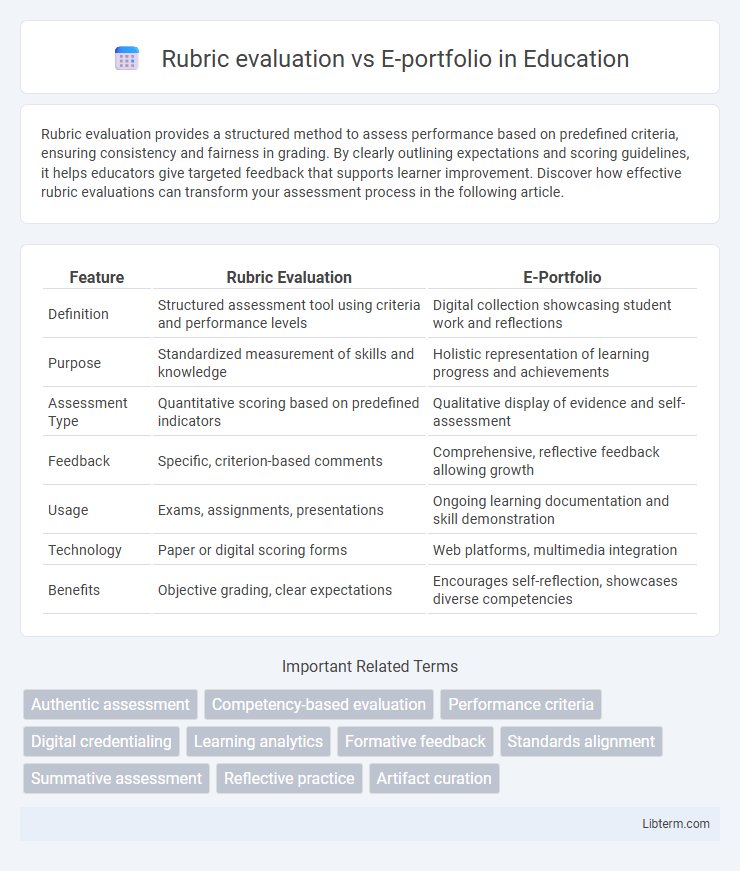Rubric evaluation provides a structured method to assess performance based on predefined criteria, ensuring consistency and fairness in grading. By clearly outlining expectations and scoring guidelines, it helps educators give targeted feedback that supports learner improvement. Discover how effective rubric evaluations can transform your assessment process in the following article.
Table of Comparison
| Feature | Rubric Evaluation | E-Portfolio |
|---|---|---|
| Definition | Structured assessment tool using criteria and performance levels | Digital collection showcasing student work and reflections |
| Purpose | Standardized measurement of skills and knowledge | Holistic representation of learning progress and achievements |
| Assessment Type | Quantitative scoring based on predefined indicators | Qualitative display of evidence and self-assessment |
| Feedback | Specific, criterion-based comments | Comprehensive, reflective feedback allowing growth |
| Usage | Exams, assignments, presentations | Ongoing learning documentation and skill demonstration |
| Technology | Paper or digital scoring forms | Web platforms, multimedia integration |
| Benefits | Objective grading, clear expectations | Encourages self-reflection, showcases diverse competencies |
Introduction to Rubric Evaluation and E-Portfolios
Rubric evaluation provides a structured framework to assess student performance through predefined criteria and levels of achievement, enabling consistent and transparent grading. E-portfolios serve as digital repositories showcasing learners' work, reflections, and progress over time, facilitating comprehensive assessment beyond traditional exams. Integrating rubric evaluation with e-portfolios enhances holistic learning assessment by aligning qualitative feedback with documented growth and skill development.
Defining Rubric Evaluation in Education
Rubric evaluation in education is a scoring guide used to assess students' performance based on predetermined criteria and levels of achievement, providing objective and consistent feedback. It breaks down assignments into specific components such as content accuracy, creativity, and presentation quality, enabling transparent grading and targeted improvements. Unlike e-portfolios, which compile diverse student work over time, rubrics emphasize standardized assessment for individual tasks to ensure clarity and fairness.
Understanding E-Portfolio Assessment
E-portfolio assessment emphasizes the holistic evaluation of student learning by collecting diverse digital artifacts that demonstrate skills, reflections, and development over time, contrasting with rubric evaluation's structured, criteria-based scoring. E-portfolios provide a dynamic, individualized insight into learners' progress, fostering self-assessment and critical thinking. This approach supports a comprehensive understanding of student achievement beyond quantitative rubric scores by capturing authentic learning experiences.
Key Differences Between Rubric Evaluation and E-Portfolio
Rubric evaluation relies on predefined criteria and quantitative scores to assess student performance systematically, whereas e-portfolios emphasize qualitative reflection and holistic presentation of a learner's work over time. Rubrics provide standardized, objective grading measures ideal for comparing achievements across students, while e-portfolios offer a personalized, interactive showcase enabling continuous self-assessment and growth tracking. The key difference lies in rubrics' structured assessment framework versus e-portfolios' flexible, narrative-based documentation of skills and accomplishments.
Benefits of Using Rubric Evaluation
Rubric evaluation provides clear criteria and standardized scoring that enhances objectivity and consistency in assessment, ensuring fair evaluation across diverse learners. It facilitates targeted feedback by identifying specific strengths and weaknesses, promoting focused improvement in student performance. Rubric evaluation streamlines the grading process, saving educators time while maintaining transparency and aligning assessments with learning outcomes.
Advantages of E-Portfolio Assessment
E-portfolio assessment offers comprehensive evidence of student learning by allowing the inclusion of diverse multimedia artifacts, reflections, and continuous progress tracking, which surpasses the static nature of rubric evaluations. This method supports personalized feedback and self-assessment, enhancing student engagement and metacognitive skills. E-portfolios also facilitate longitudinal assessment, enabling educators to monitor growth over time and align learning outcomes with professional standards effectively.
Limitations and Challenges of Rubric Evaluation
Rubric evaluation faces limitations such as rigid criteria that may overlook individual creativity and context-specific nuances, leading to reduced flexibility in assessment. This method challenges evaluators with potential bias in scoring due to subjective interpretation of rubric descriptors, impacting consistency. The inability of rubrics to capture the full spectrum of student learning processes contrasts with e-portfolios' dynamic and comprehensive showcase of skills and progress over time.
Limitations and Challenges of E-Portfolio Assessment
E-portfolio assessment faces challenges such as inconsistencies in evaluation criteria and subjective grading due to varying instructor interpretations of student reflections and artifacts. Technical issues, including platform usability and digital literacy disparities among students, can hinder effective submission and review of e-portfolios. Moreover, e-portfolios require substantial time commitments from both students and educators, complicating scalability in large classes.
Best Practices for Integrating Both Methods
Integrating rubric evaluations with e-portfolios enhances assessment accuracy by combining structured criteria with rich evidence of student learning. Best practices include aligning rubric criteria with portfolio artifacts to ensure consistency and transparency, and providing ongoing feedback through digital platforms to support continuous improvement. Implementing synchronized timelines for portfolio submissions and rubric assessments fosters timely evaluation and comprehensive skill development.
Choosing the Right Assessment Tool for Different Learning Outcomes
Rubric evaluation offers a structured, criteria-based assessment ideal for measuring specific skills and knowledge, providing clear performance standards for both educators and students. E-portfolios emphasize holistic learning by showcasing a collection of work over time, fostering reflection and demonstrating growth across diverse competencies and creative projects. Selecting the appropriate tool depends on learning outcomes: rubrics suit objective, standardized assessments, while e-portfolios excel in evaluating integrative, developmental, and reflective learning processes.
Rubric evaluation Infographic

 libterm.com
libterm.com